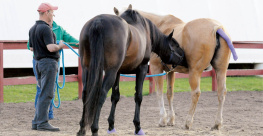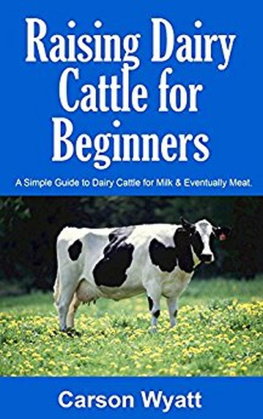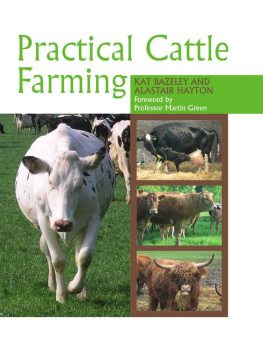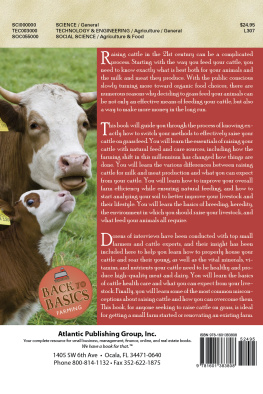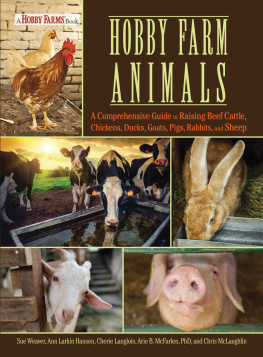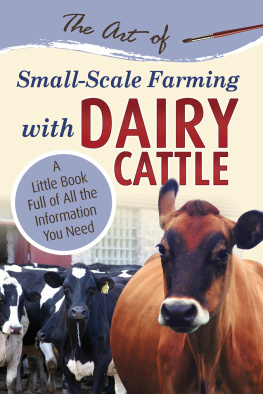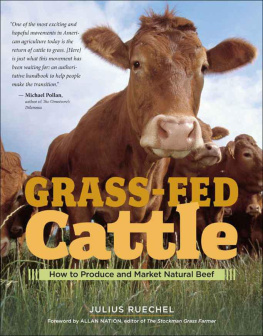The Cattle Health Handbook

The
Cattle
Health
Handbook
Preventive care, Disease Treatments
& Emergency Procedures
for Promoting the Well-Being of Your Beef or Dairy Herd
HEATHER SMITH THOMAS

The mission of Storey Publishing is to serve our customers by
publishing practical information that encourages
personal independence in harmony with the environment.
Edited by Rebekah Boyd-Owens, Sarah Guare, and Deborah Burns
Art direction and book design by Dan O. Williams
Text production by Liseann Karandisecky and Ponderosa Pine Design
Front cover and spine photographs by Lynn Stone. Authors photograph by
Andrea Hansen
Interior photographs by the author, except for Lynn Stone, page ii; Matt Pound, page
158; courtesy of Dr. Dan Casteel, University of Missouri, page 202 top; courtesy of
Dr. Marlin Rice, Iowa State University, page 299
Illustrations by Elara Tanguy
Additional maps and infographics by Ilona Sherratt
Indexed by Christine R. Lindemer, Boston Road Communications
2009 by Heather Smith Thomas
All rights reserved. No part of this book may be reproduced without written permission from the publisher, except by a reviewer who may quote brief passages or reproduce illustrations in a review with appropriate credits; nor may any part of this book be reproduced, stored in a retrieval system, or transmitted in any form or by any means electronic, mechanical, photocopying, recording, or other without written permission from the publisher.
The information in this book is true and complete to the best of our knowledge. All recommendations are made without guarantee on the part of the author or Storey Publishing. The author and publisher disclaim any liability in connection with the use of this information. For additional information, please contact Storey Publishing, 210 MASS MoCA Way, North Adams, MA 01247.
Storey books are available for special premium and promotional uses and for customized editions. For further information, please call 1-800-793-9396.
Printed in the United States by Versa Press
10 9 8 7 6 5 4 3 2 1
Library of Congress Cataloging-in-Publication Data
Thomas, Heather Smith, 1944
The cattle health handbook / by Heather Smith Thomas.
p. cm.
Includes index.
ISBN 978-1-60342-090-7 (pbk.: alk. paper)
ISBN 978-1-60342-095-2 (hardcover: alk. paper)
1. CattleHealthHandbooks, manuals, etc.
2. CattleDiseasesHandbooks, manuals, etc. I. Title.
SF961.T46 2009
636.2'089dc22
2009001484
DEDICATION
This book is dedicated to all my cattle every individual animal Ive been privileged to know, starting with my very first cow in 1956 when I was 12 years old. She was a pregnant Hereford heifer in the first group of cows my father purchased after our family bought a small ranch. I named my heifer Bovina and earned her purchase price by working summers for my father, irrigating the fields, digging postholes, and helping to build fences. I kept all of Bovinas heifer calves and their babies (selling only the steers) and had a small herd of cows by the time I went to college.
Later my husband Lynn and I had a dairy for a short time and then began raising beef cattle. Even after raising more than 6,000 calves and watching many of them grow up to be cows, I remember most of them (and their names)! Each one was a unique character; some had very endearing attributes, and others had not-so-endearing traits.
My cattle have been my passion, my addiction, my lifework. Learning how to care for them properly and how to deal with the problems that occasionally arose led me to share that knowledge with others, writing articles for livestock publications and then books about raising cattle. My cows taught me many lessons in life, not only in animal husbandry but also in larger matters regarding things like patience, courage, endurance, determination, and persistence, for its not always easy to care for them in harsh weather or to save one that suffers from a challenging disease. I am grateful to my cattle for helping to forge the person Ive become.
Contents
Preface
My husband and I both grew up on ranches raising cattle, and together weve been taking care of cattle for more than 40 years. After our wedding in March 1966, we went home to his dairy in southern Idaho to milk the cows you cant explain time off for a honeymoon to a dairy cow. Lynn had a small dairy herd, as it was easier then for a young person to obtain financing for renting a farm and buying dairy cows than to try to start up a beef-cattle ranch. Our experiences with dairy cows and their calves augmented our youthful knowledge about caring for cattle and keeping them healthy.
At the end of that year we sold the dairy cows, moved back to our mountainous country roots near Salmon, Idaho, and started our own cattle ranch. It was tough trying to make a living and pay for a ranch and cattle on what can only be called marginal land. We have many acres, and its beautiful country, but its steep, rugged, high-desert rangeland with very little rainfall and only a few acres that can be irrigated to grow hay for winter feed. But we were persistent. We struggled hard to make it work, developing a hardy, unpampered herd of crossbred cattle that thrive in harsh conditions.
Part of our financial survival depended on not losing any animals; we couldnt afford to lose any. We learned all we could about taking good care of the cattle, and early on we became excellent cattle doctors, because each animal had to be healthy and producing or fit to sell in the fall. But we also love our animals. Each one is a unique personality even after our herd expanded to 185 cows, every cow and calf had a name! If one of them was injured or sick, we were diligent in our efforts to treat him and correct the problem. We are poor losers; theres nothing we hated more than losing an animal partly because we could not afford the financial loss but also because each was a cherished character.
Learning everything we could from each adverse situation and medical case that needed treatment or intensive care, we became excellent cattle caretakers. Over the years, we learned from our local veterinarians and other ranchers and, for unusual cases, sometimes even picked the brains of university veterinary specialists. But our cattle taught us the most.
In my research as a freelance writer, I interviewed many veterinarians and professors for articles that appeared in horse and cattle publications. Ive written more than 7,000 magazine articles and now write regularly for about 60 horse, farm, and livestock publications. For 30 years Ive written a regular column on ranch life for a Canadian farming newspaper. Much of what I write deals with health care. My goal as a writer has been to learn all I can about my own animals and to share that knowledge with others. After reading my articles, ranchers have been known to phone us from great distances to ask questions about an animal they are treating, and we always take the time to try to help.
After my first four years of college, I planned on studying to become a veterinarian. Instead, I married a rancher, but my education has never ceased. We are forever consulting with veterinarians and utilizing numerous veterinary textbooks. When Lynn and I have a problem we cant handle by ourselves, such as a Cesarean-section surgery or a calf that has a hair-ball blockage or needs a section of intestine removed, we do not hesitate to call our vet. And if ranchers ask our advice about a condition we cant diagnose or havent experienced, we always refer them to their own veterinarian. But in many instances our practical knowledge can be of help to others, especially young ranchers or those just starting out who have never encountered certain situations.
Next page

